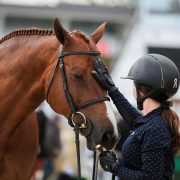Jenn Holling Clinic Recap: Same Song, Turn Up The Volume

I had the pleasure to ride with international three-day event rider, Jennifer Holling, at a clinic in Dade City, Fla., recently. Jenn, who is one-half of Holling Eventing with her fellow international event riding husband, Jonathan, is based in Ocala. On this lovely warm weekend, she schooled me and several others over fences and in flatwork at Parrish Oaks Farm run by Leah Khorsandian.
Here are my takeaways from a day of riding with Jenn.
Effective Riding is Effective Riding.
It didn’t take long – like literally two strides – for Jenn to realize I wasn’t like the rest of the group. I’m a dabbler, in that I compete in a variety of disciplines, and eventing isn’t my No. 1. She asked me first thing if I was a hunter rider. Was it that obvious?
But that didn’t mean what I learned that day was a moot point. “Effective riding is effective riding,” Jenn told me. We worked on maintaining straightness through the fences, from standard lines to bending ones, and through in-and-outs. Jenn helped me develop and maintain appropriate pace, reminding me of “same song, turn up the volume” when I wanted to take my leg off. You shouldn’t be afraid to keep the leg on, Jenn explained. It’s all about maintaining tempo and rhythm to set a good tone for an effective course.
Close. Your. Damn. Fingers.
Maybe this is a “me” problem, but I’m very fluid with my hands and fingers, and probably too much so. When I soften my grip on the reins, I tend to let them slide through my fingers. Jenn was quick to get on me about this. She asked me to envision my arms as an extension of the reins. Instead of giving the reins away, to soften I could be fluid in my elbow and give with my arms. It look a few tries (and a lot of hard thinking) to get into this new habit. But hey, it worked. And I wasn’t in a rush to gather up the reins after a big oxer.
Footwork Makes The Dream Work.
I rode in a group with similarly skilled Novice level riders. But we didn’t jump a 2’11” fence the whole day. The courses were smaller. Jenn said it wasn’t the height that mattered – it was the footwork – essentially the flatwork in between the fences – that made all the difference in coursework. We started out jumping through a seven-stride line with three cavalettis set in the middle. The horses had to jump in, settle for the three strides through poles, and then jump out. It reinforced the half-halt but it encouraged me, as the rider, to “do something” with myself, as Jenn put it. “Don’t just sit there,” she told me, put my leg on through my thigh to help keep the balance and keep the energy flowing.
Don’t Be Afraid Of Forward.
Maybe it’s because I grew up in the hunters, but I’ve always ridden with a “less is more” approach. Once I’ve set the rhythm I want, I soften and get out of my horse’s way, or so I thought. As Jenn quickly pointed out, in reality I just stop riding. In the dressage work, Jenn had me practice applying pressure with my calf and ankle on the downside of every posting trot. My horse didn’t bolt forward. Instead, he’d steady himself in his pace, lifting in his back and thus, giving me more control over his gaits. While jumping, Jenn pushed me to “squat” through the turns and in between the fences, adding pressure through my thighs to maintain the tempo, which in turn, helped keep my horse off his forehand, kept him balanced, and helped me maintain some semblance of energy in his stride. When I took my leg off, my horse wouldn’t stop, but his his gaits would just begin to unravel somewhat, and naturally he’d tend to start leaning on the forehand. This reminder from my leg was all he needed to keep moving with some impulsion. It struck the right tone.
So as Jenn said, effective riding is effective riding. The tips and methods I picked up from her I know I’ll use in any arena, not just on the cross-country course.


